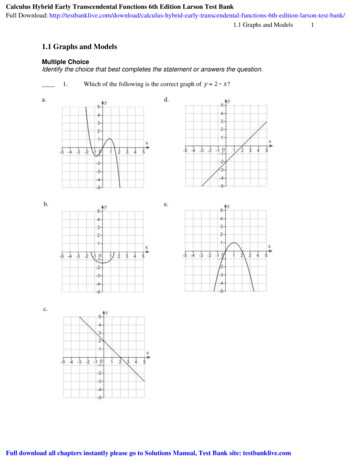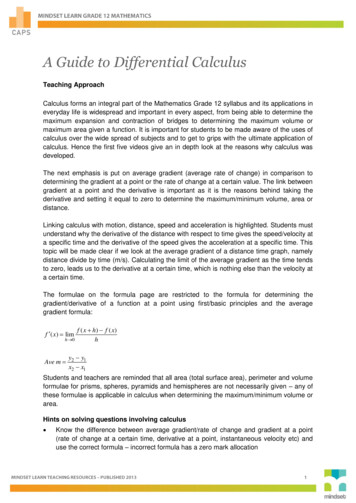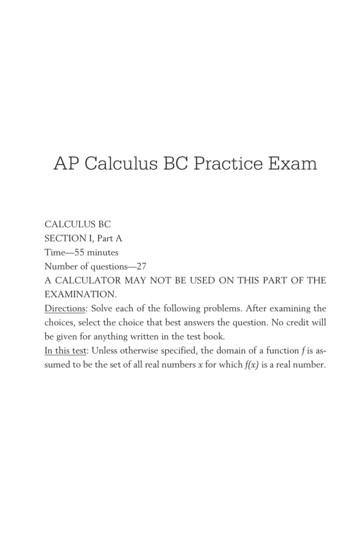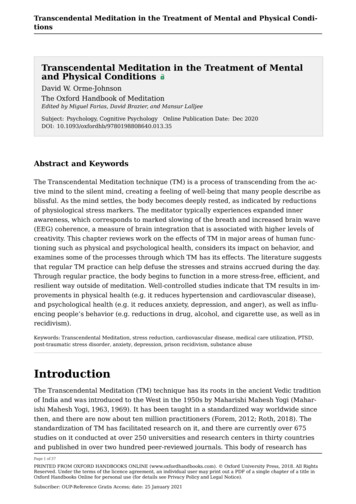
Transcription
Calculus Hybrid Early Transcendental Functions 6th Edition Larson Test BankFull Download: est-bank/1.1 Graphs and Models11.1 Graphs and ModelsMultiple ChoiceIdentify the choice that best completes the statement or answers the question.1.Which of the following is the correct graph ofa.d.b.e.?c.Full download all chapters instantly please go to Solutions Manual, Test Bank site: testbanklive.com
2Chapter 1: Preparation of Calculus2.Which of the following is the correct graph ofa.d.b.e.c.?
1.1 Graphs and Models3.Which of the following is the correct graph ofa.d.b.e.c.?3
4Chapter 1: Preparation of Calculus4.Which of the following is the correct graph ofa.d.b.e.c.?
1.1 Graphs and Modelsa.b.c.d.e.7.Find all intercepts:8.Test for symmetry with respect to each axis and to the origin.symmetric with respect to the originsymmetric with respect to the x-axissymmetric with respect to the y-axisno symmetryA, B, and Ca.b.c.d.e.Find all intercepts:x-intercepts: (–5, 0), (–2, 0), (2, 0); y-intercepts: (0, 0), (0, 10)x-intercepts: (–5, 0), (2, 0); y-intercept: (0, 10)x-intercepts: (–5, 0), (2, 0); y-intercept: (0, –10)x-intercepts: (–5, 0), (–2, 0), (2, 0); y-intercept: (0, 10)x-intercepts: (–5, 0), (–2, 0), (2, 0); y-intercept: (0, –10)a.b.c.d.e.6.x-intercepts: (–8, 0), (8, 0); no y-interceptx-intercept: (0, 0); y-intercepts: (0, 0), (0, –8), (0, 8)x-intercepts: (0, 0), (–8, 0), (8, 0); y-intercept: (0, 0)x-intercepts: (0, 0), (–8, 0), (8, 0); no y-interceptx-intercepts: (–8, 0), 8; y-intercept: (0, 0)a.b.c.d.e.Find all intercepts:x-intercepts: ( ,0), ( ,0); y-intercepts: (0, ), (0, 3)x-intercept: (12, 0); y-intercepts: (0, ), (0, 3)x-intercepts: (4, 0), (–3,0); y-intercept: (0,)x-intercepts: ( , 0), ( ,0); y-intercepts: (0, –12), (0, 12)x-intercept: ( , 0); y-intercept: (0, –12)a.b.c.d.e.5.9.Test for symmetry with respect to each axis and to the origin.symmetric with respect to the originsymmetric with respect to the y-axissymmetric with respect to the x-axisboth B and Cno symmetry5
6Chapter 1: Preparation of Calculus10.Sketch the graph of the equation:a.d.b.e. none of the abovec.
1.1 Graphs and Models11.Sketch the graph of the equation:a.d.b.e.c.7
8Chapter 1: Preparation of Calculus12.Sketch the graph of the equation:a.d.b.e. none of the abovec.
1.1 Graphs and Models13.9Find the points of intersection of the graphs of the equations:a.b.c.d.e.14.The table given below shows the Consumer Price Index (CPI) for selected years. Use theregression capabilities of a graphing utility to find a mathematical model of the formfor thedata. In the model, y represents the CPI and t represents the year, withcorresponding to 1975. Round allnumerical values in your answer to three decimal 3.630.752.470.592.5
10Chapter 1: Preparation of Calculus15.The table given below shows the Consumer Price Index (CPI) for selected years. Use a.graphing utility to plot the data and graph the 2.550.5a.d.b.e.
1.1 Graphs and Models11c.16.The table given below shows the Consumer Price Index (CPI) for selected years. Thewhere y represents the CPImathematical model for the data given below isand t represents the year, withcorresponding to 1975. Use the model to predict the CPI for the year2010. Round your answer to the nearest 71.294.3a.b.c.d.e.integer.a.b.c.d.e.17.Find the sales necessary to break evenand the revenue R for selling x units isif the cost C of producing x units is. Round your answer to the nearest
12Chapter 1: Preparation of Calculus18.The resistance y in ohms of 1000 feet of solid metal wire atmodelwhere x is the diameter of the wire in mils (0.001 in). Use a graphingutility to graph the modela.d.b.e.c.can be approximated by the
1.1 Graphs and Modelsmodel19.The resistance y in ohms of 1000 feet of solid metal wire at13can be approximated by thewhere x is the diameter of the wire in mils (0.001 in). If the diameterof the wire is doubled, the resistance is changed by approximately what factor? In determining your answer,you can ignore the constant –0.37.a.b.c.d.e.
14Chapter 1: Preparation of Calculus1.1 Graphs and ModelsAnswer EF: Section 1.1Identify the graph of a linear equationMSC: SkillANS:EPTS:1DIF:EasyREF: Section 1.1Identify the graph of a semicircleMSC: SkillANS:BPTS:1DIF:EasyREF: Section 1.1Identify the graph of a quadratic equationMSC: SkillANS:BPTS:1DIF:EasyREF: Section 1.1Identify the graph of a cubic equationMSC: SkillANS:CPTS:1DIF:EasyREF: Section 1.1Calculate the intercepts of an equationMSC: SkillANS:CPTS:1DIF:EasyREF: Section 1.1Calculate the intercepts of an equationMSC: SkillANS:DPTS:1DIF:EasyREF: Section 1.1Calculate the intercepts of an equationMSC: SkillANS:EPTS:1DIF:EasyREF: Section 1.1Identify the type of symmetry of the graph of an equationMSC: SkillANS:APTS:1DIF:EasyREF: Section 1.1Identify the type of symmetry of the graph of an equationMSC: SkillANS:CPTS:1DIF:MedREF: Section 1.1Graph a cubic equation in yMSC: SkillANS:BPTS:1DIF:EasyREF: Section 1.1Graph a quadratic equation in yMSC: SkillANS:DPTS:1DIF:MedREF: Section 1.1Graph an absolute value equationMSC: SkillANS:CPTS:1DIF:MedREF: Section 1.1Calculate the points of intersection of the graphs of equationsMSC: SkillANS:APTS:1DIF:EasyREF: Section 1.1Write a quadratic model for data using the regression capabilities of a graphing utilityMSC: ApplicationANS:BPTS:1DIF:EasyREF: Section 1.1Plot a quadratic model for data using the regression capabilities of a graphing utilityMSC: ApplicationANS:EPTS:1DIF:EasyREF: Section 1.1Evaluate a quadratic model in applicationsMSC: ApplicationANS:DPTS:1DIF:MedREF: Section 1.1Solve for the break-even point in applicationsMSC: ApplicationANS:BPTS:1DIF:MedREF: Section 1.1Plot a rational model using the capabilities of a graphing utilityMSC: ApplicationANS:DPTS:1DIF:MedREF: Section 1.1Interpret a rational modelMSC: Application
1.2 Linear Models and Rates of Change1.2 Linear Models and Rates of ChangeMultiple ChoiceIdentify the choice that best completes the statement or answers the question.1.Estimate the slope of the line from the graph.2.Sketch the line passing through the point (3, 4) with the slopea.b. 5c. 2d.e.a.d.15
16Chapter 1: Preparation for Calculuse.b.c.a.b.c.d. 0e.3.Find the slope of the line passing through the pair of points.
1.2 Linear Models and Rates of Change4.Find the slope of the line passing through the pointsand.a. 63b. 21c. 42d. 21e. 425.If a line has slopeand passes through the pointfollowing points does the line also pass?, through which of thea.b.c.d.e.6.A moving conveyor is built to rise 5 meters for every 7 meters of horizontal change.Find the slope of the conveyor.a. 0b.c.d.e.7.A moving conveyor is built to rise 1 meter for every 5 meters of horizontal change.Suppose the conveyor runs between two floors in a factory. Find the length of the conveyor if thevertical distance between floors is 10 meters. Round your answer to the nearest meter.a.b.c.d.e.61 meters39 meters51 meters50 meters41 meters17
18Chapter 1: Preparation for Calculus8.Find the slope of the line9.Find the y-intercept of the line.a.b.c.d.e.a.b.c.d.e.10.Find an equation of the line that passes through the pointthat is undefined.and has the slope ma.b.c.d.e.11.Find an equation of the line that passes through the point.a.b.c.d.e.– 162and has the slope
1.2 Linear Models and Rates of Change12.Find an equation of the line that passes through the points13.Find an equation of the line that passes through the b.c.d.e.Use the result, “the line with intercepts,.has the equation”, to write an equation of the line with x-intercept:19and y-
20Chapter 1: Preparation for Calculus15.Sketch a graph of the equationa.d.b.e.c.
1.2 Linear Models and Rates of Change16.Write an equation of the line that passes through the given point and is perpendicularto the given line.a.b.c.d.e.17.given line.Write an equation of the line that passes through the given point and is parallel to thea.b.c.d.e.18.Write an equation of the line that passes through the pointperpendicular to the lineand is.a.b.c.d.e.the linea.b.c.d.e.19.Write an equation of the line that passes through the point.and is parallel to21
22Chapter 1: Preparation for Calculusisand the rate at which the20.Suppose that the dollar value of a product invalue of the product is expected to increase per year during the next years is. Write a linearequation that gives the dollar value of the product in terms of the year . (Letrepresent.)Round the numerical values in your answer to one decimal place, where applicable.a.b.c.d.e.21.Find an equation of the line through the points of intersection ofand.a.b.c.d.e.22.A company reimburses its sales representativesper day for lodging and mealsplus per mile driven. Write a linear equation giving the daily cost to the company in terms of ,the number of miles driven. Round the numerical values in your answer to two decimal places, whereapplicable.a.b.c.d.e.23.A company reimburses its sales representativesper day for lodging and mealsplus per mile driven. How much does it cost the company if a sales representative drivesmiles on a given day? Round your answer to the nearest cent.a.b.c.d.e.227.20216.70136.35161.35191.70
1.2 Linear Models and Rates of Change24.A real estate office handles an apartment complex with units. When the rent isper month, all units are occupied. However, when the rent is, the average number ofoccupied units drops to . Assume that the relationship between the monthly rent and the demandis linear. Write a linear equation giving the demand in terms of the rent .a.b.c.d.e.25.A real estate office handles an apartment complex with units. When the rent isper month, all units are occupied. However, when the rent is , the average number ofoccupied units drops to . Assume that the relationship between the monthly rent and the demandis linear. Predict the number of units occupied if the rent is raised to.a. 43 unitsb. 54 unitsc. 57 unitsd. 49 unitse. 46 units26.Find the distance between the pointand linefor the distance between the point.a.b.c.d.e.using the formula,and the line23
24Chapter 1: Preparation for Calculus1.2 Linear Models and Rates of ChangeAnswer Section1.ANS:BPTS:1DIF:EasyREF: Section 1.2OBJ: Estimate the slope of a line from its graphMSC: Skill2.ANS:DPTS:1DIF:EasyREF: Section 1.2OBJ: Sketch the line passing through a point with specified slopeMSC: Skill3.ANS:BPTS:1DIF:EasyREF: Section 1.2OBJ: Calculate the slope of a line passing through two pointsMSC: Skill4.ANS:CPTS:1DIF:MedREF: Section 1.2OBJ: Calculate the slope of a line passing through two pointsMSC: Skill5.ANS:APTS:1DIF:MedREF: Section 1.2OBJ: Identify a point on a line with specified propertiesMSC: Skill6.ANS:BPTS:1DIF:EasyREF: Section 1.2OBJ: Calculate slopes in applicationsMSC: Application7.ANS:CPTS:1DIF:MedREF: Section 1.2OBJ: Calculate slopes in applicationsMSC: Application8.ANS:EPTS:1DIF:MedREF: Section 1.2OBJ: Manipulate a linear equation to determine its slopeMSC: Skill9.ANS:APTS:1DIF:MedREF: Section 1.2OBJ: Manipulate a linear equation to determine its y-interceptMSC: Skill10.ANS:BPTS:1DIF:EasyREF: Section 1.2OBJ: Write an equation of a line given a point on the line and its slopeMSC: Skill11.ANS:BPTS:1DIF:EasyREF: Section 1.2OBJ: Write an equation of a line given a point on the line and its slopeMSC: Skill12.ANS:DPTS:1DIF:EasyREF: Section 1.2OBJ: Write an equation of a line given two points on the lineMSC: Skill13.ANS:EPTS:1DIF:MedREF: Section 1.2OBJ: Write an equation of a line given two points on the lineMSC: Skill14.ANS:EPTS:1DIF:EasyREF: Section 1.2MSC: SkillOBJ: Write an equation of a line given its x- and y-intercepts15.ANS:BPTS:1DIF:MedREF: Section 1.2OBJ: Sketch the graph of a linear equationMSC: Skill16.ANS:CPTS:1DIF:MedREF: Section 1.2OBJ: Write an equation of a line given a point on the line and a line to which it isparallel/perpendicularMSC: Skill17.ANS:APTS:1DIF:MedREF: Section 1.2OBJ: Write an equation of a line given a point on the line and a line to which it isparallel/perpendicularMSC: Skill18.ANS:APTS:1DIF:MedREF: Section1.2OBJ:Write an equation of a line given a point on the line and a line to which it is perpendicularMSC: Skill19.ANS:APTS:1DIF:EasyREF: Section 1.2OBJ: Write an equation of a line given a point on the line and a line to which it is parallelMSC: Skill20.ANS:DPTS:1DIF:EasyREF: Section 1.2OBJ: Write linear equations in applicationsMSC: Application
1.2 Linear Models and Rates of Change21. ANS: DPTS: 1DIF: MedREF: Section 1.2OBJ: Write an equation of a line through the points of intersection of quadratic equationsMSC: Skill22.ANS:BPTS:1DIF:EasyREF: Section 1.2OBJ: Write linear equations in applicationsMSC: Application23.ANS:BPTS:1DIF:EasyREF: Section 1.2OBJ: Evaluate linear equations in applicationsMSC: Application24.ANS:DPTS:1DIF:MedREF: Section 1.2OBJ: Write linear equations in applicationsMSC: Application25.ANS:EPTS:1DIF:EasyREF: Section 1.2OBJ: Evaluate linear equations in applicationsMSC: Application26.ANS:CPTS:1DIF:MedREF: Section 1.2OBJ: Calculate the distance between a point and a lineMSC: Skill25
26Chapter 1: Preparation for Calculus1.3 Functions and Their GraphsMultiple ChoiceIdentify the choice that best completes the statement or answers the question.a.b.c.d.e.Evaluate (if possible) the functionat2.Evaluate (if possible) the functionat3.Evaluate (if possible) the function1. Simplify the result.–71737undefined. Simplify the result.a.b.c.d.e.at. Simplify the result.a.b.c.d.e. none of the above4.a.b.c.d.e. undefinedLet. Then simplify the expression.
1.3 Functions and Their Graphs5.Let. Evaluate the expressionand then simplify theresult.a.b.c.d.e. undefined6.Find the domain and range of the function.a. domain:range:b. domain:range:c. domain:range:d. domain:range:e. domain:range:7.Find the domain and range of the functiona. domain:range:b. domain:range:c. domain:range:d. domain:range:e. none of the above.27
28Chapter 1: Preparation for Calculus8.Find the domain and range of the functiona. domain:range:b. domain:range:c. domain:range:d. domain:range:e. domain:range:9.Evaluate the functionat10.Determine the domain and range of the function.a.b.c.d.e.a. domain:range:b. domain:range:c. domain:range:d. domain:range:e. domain:range:a. nob. yes11.Determine whether y is a function of x.
1.3 Functions and Their Graphs12.Determine whether y is a function of x.13.Use the graph of29a. nob. Yesa.given below to find the graph of the functiond.
30Chapter 1: Preparation for Calculuse.b.c.14.Use the graph ofgiven below to find the graph of the function.
1.3 Functions and Their Graphsa.d.b.e.c.31
32Chapter 1: Preparation for Calculus15.Specify a sequence of transformations for the functionwill yield the graph of h from the graph of the functiona.The functionby a vertical shiftb.e.to the left, followed byis a horizontal shiftto the left, followed byto the right.is a vertical shiftdownwards, followed by ais a vertical shiftupwards, followed by ato the right.The functionhorizontal shiftis a horizontal shiftupwards.The functionhorizontal shiftto the right, followeddownwards.The functiona horizontal shiftd.is a horizontal shiftThe functiona vertical shiftc.thatto the left.16.Given17.Determine whether the function is even, odd, or neither.and, evaluate.a.b.c.d.e.a. oddb. evenc. neither
1.3 Functions and Their Graphs18.Determine whether the function is even, odd, or neither.a. evenb. oddc. neither19.Find the coordinates of a second point on the graph of a function f if the given pointis on the graph and the function is even.a.b.c.d.e.20.Find the coordinates of a second point on the graph of a function f if the given pointis on the graph and the function is odd.a.b.c.d.e.33
34Chapter 1: Preparation for Calculus21.The horsepower H required to overcome wind drag on a certain automobile isapproximated bywhere x is the speed of the car inmiles per hour. Find. Round the numerical values in your answer to five decimal places.a.b.c.d.e.22.An open box of maximum volume is to be made from a square piece of materialcentimeters on a side by cutting equal squares from the corners and turning up the sides (see figure).Write the volume V as a function of x, the length of the corner squares.a.b.c.d.e.
1.3 Functions and Their Graphs23.An open box of maximum volume is to be made from a square piece of materialcentimeters on a side by cutting equal squares from the corners and turning up the sides(see figure).What is the domain of the ain:35
36Chapter 1: Preparation for Calculus1.3 Functions and Their GraphsAnswer J:ANS:DPTS:1DIF:Evaluate a function and simplifyANS:BPTS:1DIF:Evaluate a function and simplifyANS:CPTS:1DIF:Evaluate a function and simplifyANS:BPTS:1DIF:Simplify a difference quotientANS:APTS:1DIF:Simplify a difference quotientANS:EPTS:1DIF:Identify the domain and range of a functionANS:EPTS:1DIF:Identify the domain and range of a functionANS:BPTS:1DIF:Identify the domain and range of a functionANS:EPTS:1DIF:Evaluate a piecewise functionANS:BPTS:1DIF:Identify the domain and range of a functionANS:BPTS:1DIF:Identify equations that are functionsANS:BPTS:1DIF:Identify equations that are functionsANS:EPTS:1DIF:Graph transformations of functionsANS:APTS:1DIF:Graph transformations of functionsANS:BPTS:1DIF:Describe a transformation of an equationANS:DPTS:1DIF:Evaluate composite functionsANS:CPTS:1DIF:Identify the type of symmetry of the graph of a functionANS:APTS:1DIF:Identify the type of symmetry of the graph of a functionANS:EPTS:1DIF:Identify points on a graph using symmetryANS:BPTS:1DIF:Identify points on a graph using symmetryANS:DPTS:1DIF:Apply composite functionsANS:APTS:1DIF:Create functions in MSC:REF:MSC:REF:MSC:Section 1.3SkillSection 1.3SkillSection 1.3SkillSection 1.3SkillSection 1.3SkillSection 1.3SkillSection 1.3SkillSection 1.3SkillSection 1.3SkillSection 1.3SkillSection 1.3SkillSection 1.3SkillSection 1.3SkillSection 1.3SkillSection 1.3SkillSection 1.3SkillSection 1.3SkillSection 1.3SkillSection 1.3SkillSection 1.3SkillSection 1.3ApplicationSection 1.3Application
1.3 Functions and Their Graphs23. ANS: CPTS: 1OBJ: Identify domains in applicationsDIF:MedREF: Section 1.3MSC: Application37
38Chapter 1: Preparation for Calculus1.4 Fitting Models to DataMultiple ChoiceIdentify the choice that best completes the statement or answers the question.a.b.c.d.e.1.Determine which type of function would be most appropriate to fit the given data.exponentiallinearquadraticno relationshiptrigonometric2.Which function below would be most appropriate model for the given data?
1.4 Fitting Models to Dataa.b.c.d.no apparent relationship between x and ytrigonometricquadraticlinear3.The following ordered pairs represent temperatures in degrees Fahrenheit taken eachhour from 1:00 pm until 5:00 pm. Let T be temperature, and let t be time, wherecorrespondsto 1:00 pm,corresponds to 2:00 pm, and so on. Plot the data. Visually find a linear model forthe data and find its equation. From the visual linear model that you created, determine which of themodels that follow appears to best approximate the data.(1:00 pm ,), (2:00 pm ,), (3:00 pm ,), (4:00 pm ,), (5:00 pm ,)a.b.c.d.e.4.Each ordered pair gives the exposure index x of a carcinogenic substance and thetocancer mortality y per 100,000 people in the population. Use the modelapproximate y if. Round your answer to one decimal place.a.b.c.d.e.168.2163.6182.0172.8177.45.Hooke's Law states that the force F required to compress or stretch a spring (withinits elastic limits) is proportional to the distance d that the spring is compressed or stretched from itsoriginal length. That is,where k is a measure of the stiffness of the spring and is called thespring constant. The table shows the elongation d in centimeters of a spring when a force of Fnewtons is applied. Use the regression capabilities of a graphing utility to find a linear model for thedata. Round the numerical values in your answer to three decimal places.a.b.c.d.e.39
40Chapter 1: Preparation for Calculus6.Hooke's Law states that the force F required to compress or stretch a spring (withinits elastic limits) is proportional to the distance d that the spring is compressed or stretched from itswhere k is a measure of the stiffness of the spring and is called theoriginal length. That is,spring constant. The table shows the elongation d in centimeters of a spring when a force of Fnewtons is applied. Use a graphing utility to plot the data and graph the linear model.a.d.b.e.
1.4 Fitting Models to Datac.7.Hooke's Law states that the force F required to compress or stretch a spring (withinits elastic limits) is proportional to the distance d that the spring is compressed or stretched from itsoriginal length. That is,where k is a measure of the stiffness of the spring and is called thespring constant. The table shows the elongation d in centimeters of a spring when a force of Fnewtons is applied. Use the modelto estimate the elongation of the spring when a forceof 55 newtons is applied. Round your answer to two decimal places.a.b.c.d.e.8.08 cm6.38 cm4.68 cm2.98 cm9.78 cm8.In an experiment, students measured the speed s (in meters per second) of a fallingobject t seconds after it was released. The results are shown in the table below. Use the regressioncapabilities of a graphing utility to find a linear model for the data. Round all numerical values inyour answer to one decimal place.a.b.c.d.e.41
42Chapter 1: Preparation for Calculus9.In an experiment, students measured the speed s (in meters per second) of a fallingobject t seconds after it was released. The results are shown in the table below. Use the regressioncapabilities of a graphing utility to find a linear model for the data. Round all numerical values inyour answer to one decimal place.a.d.b.e.
1.4 Fitting Models to Datac.10.In an experiment, students measured the speed s (in meters per second) of a fallingobject t seconds after it was released. The results are shown in the table below. Use the modelto estimate the speed of the object afterseconds. Round your answer to twodecimal places.a.b.c.d.e.21.05 meters/second20.95 meters/second24.25 meters/second23.55 meters/second22.65 meters/second11.Students in a lab measured the breaking strength S (in pounds) of wood 2 inchesthick, x inches high, and 12 inches long. The results are shown in the table below. Use the regressioncapabilities of a graphing utility to fit a quadratic model to the data. Round the numerical values inyour answer to two decimal places, where applicable.a.b.c.d.e.43
44Chapter 1: Preparation for Calculus12.Students in a lab measured the breaking strength S (in pounds) of wood 2 inchesthick, x inches high, and 12 inches long. The results are shown in the table below. Use a graphingutility to plot the data and graph the quadratic model.a.d.b.e.
1.4 Fitting Models to Datac.13.Students in a lab measured the breaking strength S (in pounds) of wood 2 inchesthick, x inches high, and 12 inches long. The results are shown in the table below. Use the modelto approximate the breaking strength when. Round your answerto two decimal places.a.b.c.d.e.595.98 pounds390.19 pounds957.76 pounds801.77 pounds751.97 pounds14.A V8 car engine is coupled to a dynamometer and the horsepower y is measured atdifferent engine speeds x (in thousands of revolutions per minute). The results are shown in the tablebelow. Use the regression capabilities of a graphing utility to find a cubic model for the data. Roundthe numerical values in your answer to three decimal places, where applicable.a.b.c.d.e.45
46Chapter 1: Preparation for Calculus15.A V8 car engine is coupled to a dynamometer and the horsepower y is measured atdifferent engine speeds x (in thousands of revolutions per minute). The results are shown in the tablebelow. Use a graphing utility to plot the data and graph the cubic model.a.d.b.e.
1.4 Fitting Models to Datac.16.A V8 car engine is coupled to a dynamometer and the horsepower y is measured atdifferent engine speeds x (in thousands of revolutions per minute). The results are shown in the tablebelow. Use the modelto approximate the horsepower when theengine is running at 5500 revolutions per minute. Round your answer to two decimal places.a.b.c.d.e.260.77 hp262.73 hp262.36 hp261.38 hp261.91 hp47
48Chapter 1: Preparation for Calculus1.4 Fitting Models to DataAnswer BJ:16.OBJ:ANS:APTS:1DIF:EasyREF: Section 1.4Identify the most appropriate function for a scatter plotMSC: SkillANS:DPTS:1DIF:EasyREF: Section 1.4Identify the most appropriate function for a scatter plotMSC: SkillANS:EPTS:1DIF:EasyREF: Section 1.4Identify the best linear model for given dataMSC: ApplicationANS:DPTS:1DIF:EasyREF: Section 1.4Evaluate linear models in applicationsMSC: ApplicationANS:DPTS:1DIF:EasyREF: Section 1.4Write a linear model for data using the regression capabilities of a graphing utilityMSC: ApplicationANS:DPTS:1DIF:EasyREF: Section 1.4Plot data points and the graph of a linear modelMSC: ApplicationANS:CPTS:1DIF:EasyREF: Section 1.4Evaluate linear models in applicationsMSC: ApplicationANS:APTS:1DIF:EasyREF: Section 1.4Write a linear model for data using the regression capabilities of a graphing utilityMSC: ApplicationANS:CPTS:1DIF:EasyREF: Section 1.4Plot data points and the graph of a linear modelMSC: ApplicationANS:EPTS:1DIF:EasyREF: Section 1.4Evaluate linear models in applicationsMSC: ApplicationANS:BPTS:1DIF:MedREF: Section 1.4Write a quadratic model for data using the regression capabilities of a graphing utilityMSC: ApplicationANS:BPTS:1DIF:MedREF: Section 1.4Plot data points and the graph of a quadratic modelMSC: ApplicationANS:APTS:1DIF:MedREF: Section 1.4Evaluate quadratic models in applicationsMSC: ApplicationANS:DPTS:1DIF:MedREF: Section 1.4Evaluate cubic models in applicationsMSC: ApplicationANS:DPTS:1DIF:MedREF: Section 1.4Plot data points and the graph of a cubic modelMSC: ApplicationANS:APTS:1DIF:MedREF: Section 1.4Write a cubic model for data using the regression capabilities of a graphing utilityMSC: Application
1.5 Inverse Functions1.5 Inverse FunctionsMultiple ChoiceIdentify the choice that best completes the statement or answers the question.1.Match the graph of the function given below with the graph of its inverse function.a.d.b.e.49
50Chapter 1: Preparation for Calculusc.a.2.Match the graph of the function given below with the graph of its inverse function.d.
1.5 Inverse Functionse.b.c.false.3.The functionUse the Horizontal Line Test to determine whether the following statement is true oris one-to-one on its entire domain and therefore has an inversefunction.a. falseb. truefalse.4.The functionfunction.a. trueb. falseUse the Horizontal Line Test to determine whether the following statement is true oris one-to-one on its entire domain and therefore has an inverse51
52Chapter 1: Preparation for Calculus5.is one-to-one on its entire domain.True or False: The functiona. falseb. true6.True or False: The functionis one-to-one on the domain.a. falseb. true7.Findif8.Findif.a.b.c.d.e.a.b.c.d.e.
1.5 Inverse c.d.e.a.b.c.d.e.53
54Chapter 1: Preparation for You need 50 pounds of two commodities costing 1.80 and 2.40 per pound. Find.the inverse function of the cost functiona.b.c.d.e.
1.5 Inverse Functions5515.You need 50 pounds of two commodities costing 1.60 and 1.95 per pound.Determine the number of pounds of the less expensive commodity purchased if the total cost.a.b.c.d.e.10 pounds17 pounds7 pounds5 pounds13 pounds16.Use the functionsto find the function.a.b.c.d.e.17.Use the functions18.Evaluate the expressionto find the functiona.b.c.d.e.a. 0b.c.d.e.without using a calculator.
56Chapter 1: Preparation for Calculus19.Evaluate the expressionwithout using a calculator.20.Evaluate the expressionwithout using a calculator.21.Write the following expression in algebraic form.22.Write the following expression in algebraic form.a.b.c.d.e.a.b.c. 3d. 5e. 4a.b.c.d.e.a.b.c.d.e.
1.5 Inverse Functions23.Write the following expression in algebraic form.24.Solve the following equation for .a.b.c.d.e.a.b.c.d.e.57
58Chapter 1: Preparation for Calculus25.a.b.c.d.e.Solve the following equation for .
1.5 Inverse Functions1.5 Inverse FunctionsAnswer J:ANS:APTS:1DIF:EasyIdentify the graph of the inverse of a functionANS:CPTS:1DIF:EasyIdentify the graph of the inverse of a functionANS:BPTS:1DIF:MedRecognize invertible functionsANS:APTS:1DIF:MedRecognize invertible functionsANS:BPTS:1DIF:MedRecognize invertible functionsANS:BPTS:1DIF:MedRecognize invertible functionsANS:EPTS:1DIF:EasyConstruct the inverse of a fun
Calculus Hybrid Early Transcendental Functions 6th Edition Larson Test Bank . Identify the choice that best completes the statement or answers the question. _ 1. Estimate the slope of the line from the graph. a. b. 5 . Calculus Hybrid Early Trans










